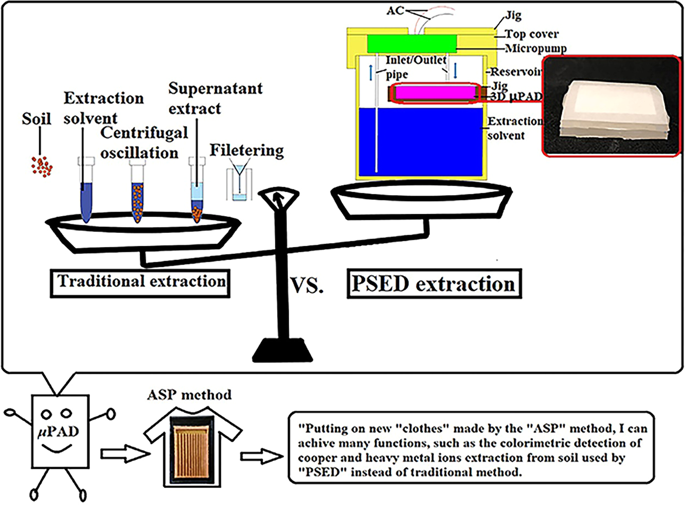Microsystems & Nanoengineering ( IF 7.3 ) Pub Date : 2020-03-09 , DOI: 10.1038/s41378-019-0123-9 Yanfang Guan 1 , Baichuan Sun 1

|
As a promising concept, microfluidic paper-based analytical devices (μPADs) have seen rapid development in recent years. In this study, a new method of fabricating μPADs by atom stamp printing (ASP) is proposed and studied. The advantages of this new method compared to other methods include its low cost, ease of operation, high production efficiency, and high resolution (the minimum widths of the hydrophilic channels and hydrophobic barriers are 328 and 312 μm, respectively). As a proof of concept, μPADs fabricated with the ASP method were used to detect different concentrations of Cu2+ via a colorimetric method. Moreover, combined with a distance-based detection method, these devices achieved a Cu2+ detection limit of down to 1 mg/L. In addition, a new paper-based solid–liquid extraction device (PSED) based on a three-dimensional (3D) μPAD with a “3 + 2” structure and a recyclable extraction mode was developed. Specifically, using the characteristics of paper filtration and capillary force, the device completed multiple extraction and filtration steps from traditional solid–liquid extraction processes with high efficiency. The developed PSED platform allows the detection of heavy metal ions much more cheaply and simply and with a faster response time at the point of care, and it has great promise for applications in food safety and environmental pollution in resource-limited areas.
中文翻译:

使用通过原子印章印刷制造的纸基分析装置检测和提取重金属离子
作为一个有前途的概念,微流体纸基分析设备(μPADs)近年来得到了快速发展。在这项研究中,提出并研究了一种通过原子印章印刷(ASP)制造 μPAD 的新方法。与其他方法相比,这种新方法的优点包括成本低、操作简便、生产效率高和分辨率高(亲水通道和疏水屏障的最小宽度分别为 328 和 312 μm)。作为概念证明,使用 ASP 方法制造的 μPAD 用于通过比色法检测不同浓度的 Cu 2+。此外,结合基于距离的检测方法,这些设备实现了 Cu 2+检测限低至 1 mg/L。此外,基于具有“3+2”结构和可回收提取模式的三维(3D)μPAD,开发了一种新型纸基固液提取装置(PSED)。具体来说,该装置利用纸过滤和毛细管力的特性,高效完成了传统固液萃取过程中的多个萃取和过滤步骤。开发的 PSED 平台可以更便宜、更简单地检测重金属离子,并且在护理点的响应时间更快,在资源有限地区的食品安全和环境污染方面具有广阔的应用前景。











































 京公网安备 11010802027423号
京公网安备 11010802027423号